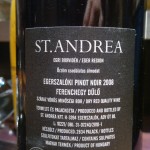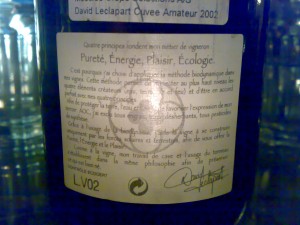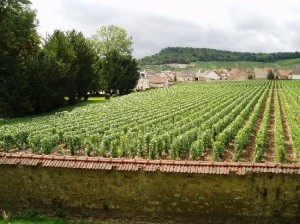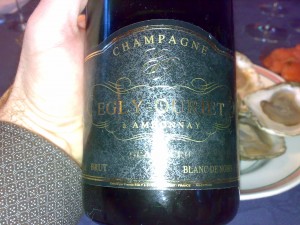May 22, 2011
A tasting note: 2008 St. Andrea Pinot Noir Ferenchegy
We are in Hungary now. Not the famous Tokaj region centered around the small town of Mad, known for its glorious sweet Aszú wines. Rather we are a bit further south and west. Perhaps the second most well-known wine region in this (perhaps under appreciated) wine producing country. We are in Eger. Home of the “Bulls Blood”, or locally “Egri Bikavér”. Although ecological conditions favor white wine production, the fame of the region lies in its reds.
St. Andrea follows a simple philosophy, one that is not so seldom heard these days: “The quality of the wine is decided in the vineyard”. Not a new way of thinking, but a more and more common way of thinking. A philosophy that for the most part I agree with. You certainly cannot make a great wine without great grapes. But one cannot ignore the wine maker. This is where a wine maker who listens carefully to his grapes can mean the difference between an average, every day bottle of wine and a great bottle of wine. Dr. György Lőrincz (owner/oenologist) says “If an oenologist reaches this level of quality and can maintain it continuously with undiminished energy for decades, his vineyard can become deservedly prestigious, and establish iconic wines that can motivate other enthusiastic oenologists.”
I heard rumors that many consider St. Andrea as the best Pinot Noir producer in the area. 2,834 bottles produced
Date tasted: May 17th, 2011 19:07
Appearance: very light in color, almost rosé like. One of the lightest Pinot’s I have seen in a while. Medium intense reflexes. Young.

 Nose: Wood, forest floor. Oak not abusive to the fruit. Ripe raspberries with smoky hints. Quite open already. Alcohol stings the nose a bit.
Nose: Wood, forest floor. Oak not abusive to the fruit. Ripe raspberries with smoky hints. Quite open already. Alcohol stings the nose a bit.
Palate: good attack and good structure. Medium plus acidity, nice fruit, oak sits around the whole wine, gently coating the tongue and mouth. Surprising freshness. Alcohol is quite fresh and doesn’t dominate the wine. For my palate, the oak is too much a piece of the puzzle. Perhaps the producer intended that this wine be stored a few years, but I’m not sure this is a wine that will improve for the next 5 years in the cellar. Judicious use of oak none the less, but it loses a bit of it’s drinkablity for me because of the oak, unfortunately. Drink now or enjoy over the next 3-5 years.








 The Clos du Mesnil is an exception to the Krug rule of blending. This wine is 100% Chardonnay from the renowned Clos du Mesnil vineyard within the village of Mesnil-sur-Oger in the Côtes de Blancs. This historic 1.85ha vineyard has been enclosed by a stone wall since 1698 and is set on a southeast-facing slope and is sheltered from the weather by its wall and surrounding houses. This vineyard was purchased by the Krug family in 1971 and started to carefully restore the vineyard to its previous glory by replanting the Chardonnay vines one section at a time. By 1979 the vintage had achieved the quality Krug was aiming for and was therefore the first vintage of the Krug Clos du Mesnil. Only about 12,000 bottles of this wine are made in only the top vintages. Even less bottles are produced in the desireable Magnum size.
The Clos du Mesnil is an exception to the Krug rule of blending. This wine is 100% Chardonnay from the renowned Clos du Mesnil vineyard within the village of Mesnil-sur-Oger in the Côtes de Blancs. This historic 1.85ha vineyard has been enclosed by a stone wall since 1698 and is set on a southeast-facing slope and is sheltered from the weather by its wall and surrounding houses. This vineyard was purchased by the Krug family in 1971 and started to carefully restore the vineyard to its previous glory by replanting the Chardonnay vines one section at a time. By 1979 the vintage had achieved the quality Krug was aiming for and was therefore the first vintage of the Krug Clos du Mesnil. Only about 12,000 bottles of this wine are made in only the top vintages. Even less bottles are produced in the desireable Magnum size.
 1985 started with the worst frost the residents of Champagne had seen in over 150 years. In January, the temperature outside reached a low of -25 Celsius (-13 Fahrenheit)! At this point, the vines were still hibernating, so no damage done. However, by the time the vines had awoken it was still -15 Celsius (5 Fahrenheit) outside resulting in around 10% of the vineyards freezing. Even into April, outside temperatures were below freezing. Thankfully, the weather changed substantially as the vines flowered and temperatures in August and September were hot. Thanks to the long Indian Summer, harvest was in late September resulting in a small harvest of very concentrated grapes. The wines made from this vintage are still quite youthful and can rest a few more years down in the cellar.
1985 started with the worst frost the residents of Champagne had seen in over 150 years. In January, the temperature outside reached a low of -25 Celsius (-13 Fahrenheit)! At this point, the vines were still hibernating, so no damage done. However, by the time the vines had awoken it was still -15 Celsius (5 Fahrenheit) outside resulting in around 10% of the vineyards freezing. Even into April, outside temperatures were below freezing. Thankfully, the weather changed substantially as the vines flowered and temperatures in August and September were hot. Thanks to the long Indian Summer, harvest was in late September resulting in a small harvest of very concentrated grapes. The wines made from this vintage are still quite youthful and can rest a few more years down in the cellar.




 Appearance: Quite an intense, glowing light red color. About as light a red as you might expect from the Pinot Noir grape – see through. But with a more intense glow. Very very slight browning around the edges, matching what I would expect from a wine of this age.
Appearance: Quite an intense, glowing light red color. About as light a red as you might expect from the Pinot Noir grape – see through. But with a more intense glow. Very very slight browning around the edges, matching what I would expect from a wine of this age.



 I surprised my small group of friends (and myself!) on one of our “gourmet pizza” evenings by pulling this wine out of my cellar. I didn’t tell the small group of 5 what it was I was surprising them with to see if they could identify the country of origin, variety and “guesstimate” the vintage… I was not surprised when they had difficulties with this blind tasting as I was a bit surprised by the vitality of the wine considering the age. Also unexpected was the bouquet which emerged from the glass.
I surprised my small group of friends (and myself!) on one of our “gourmet pizza” evenings by pulling this wine out of my cellar. I didn’t tell the small group of 5 what it was I was surprising them with to see if they could identify the country of origin, variety and “guesstimate” the vintage… I was not surprised when they had difficulties with this blind tasting as I was a bit surprised by the vitality of the wine considering the age. Also unexpected was the bouquet which emerged from the glass.
 imagine, but there was a mild sweetness at the front end when the wine first hit the tongue, but it quickly gave way to a very elegant but high level of acidity. Much more elegant in fact that many of the Karthaüser’s I have tasted in the past. Oh, of course, on the palate there were plenty of ripe lemons and a splash of kumkwat.. The wine was very concentrated and the finish very long.
imagine, but there was a mild sweetness at the front end when the wine first hit the tongue, but it quickly gave way to a very elegant but high level of acidity. Much more elegant in fact that many of the Karthaüser’s I have tasted in the past. Oh, of course, on the palate there were plenty of ripe lemons and a splash of kumkwat.. The wine was very concentrated and the finish very long.